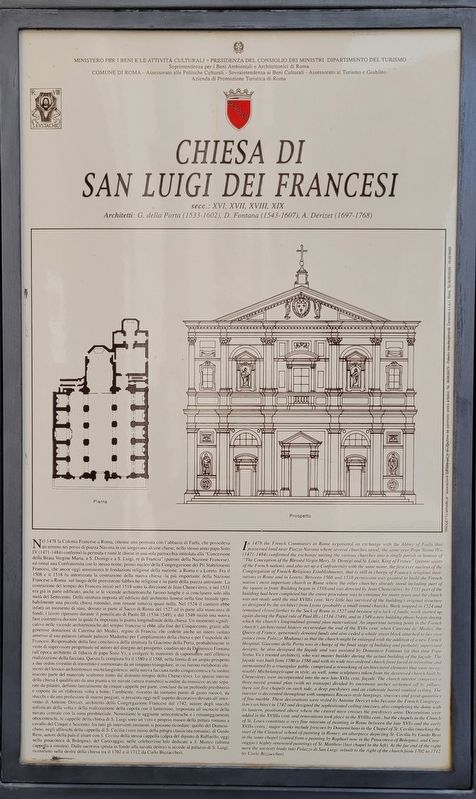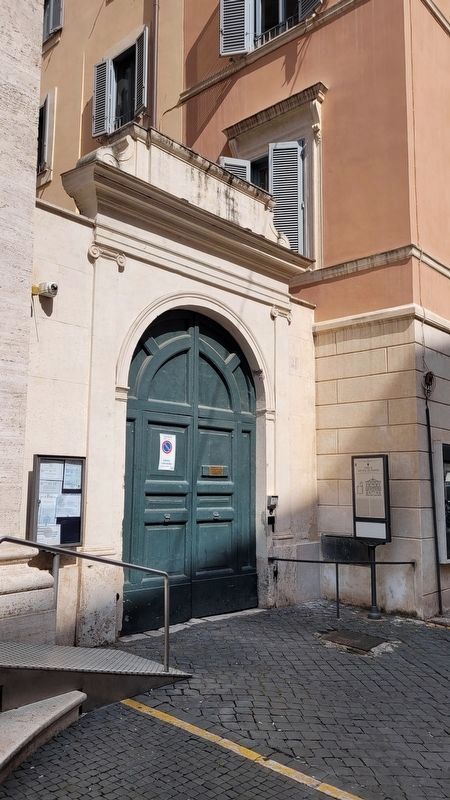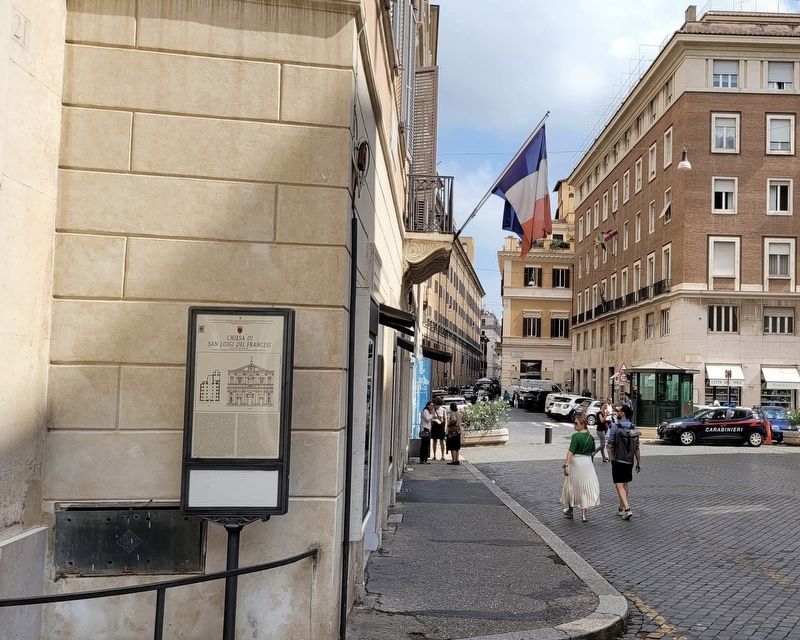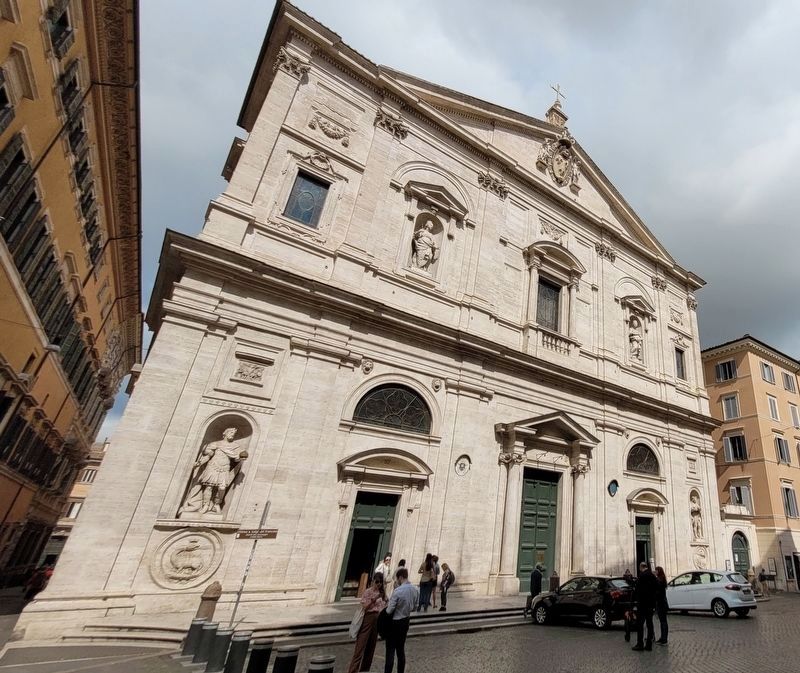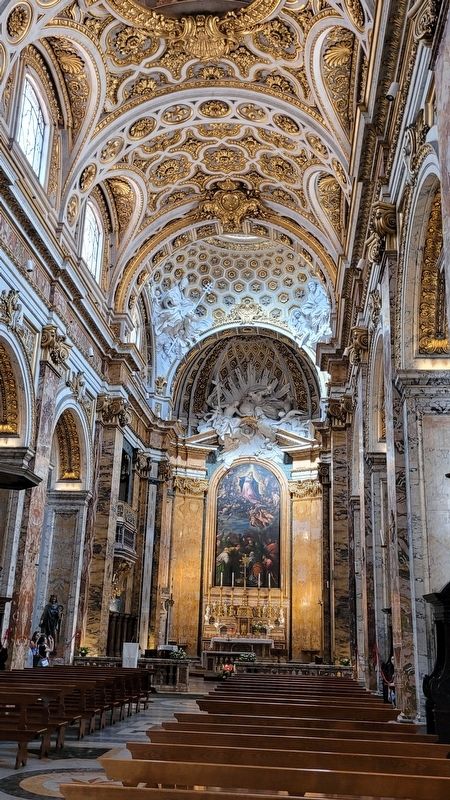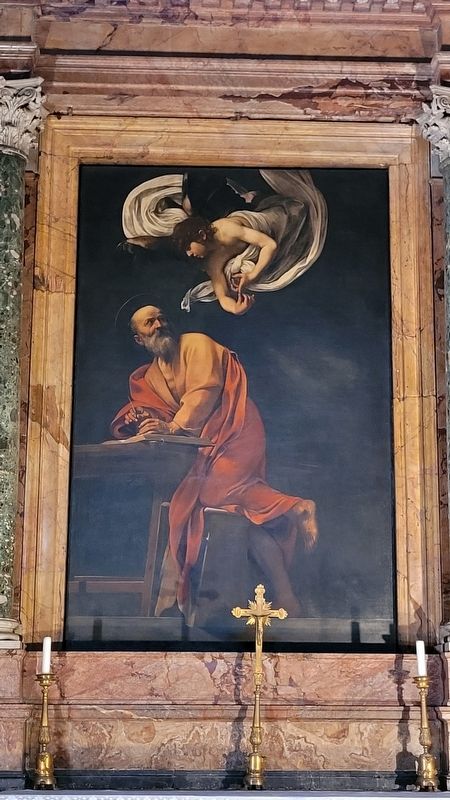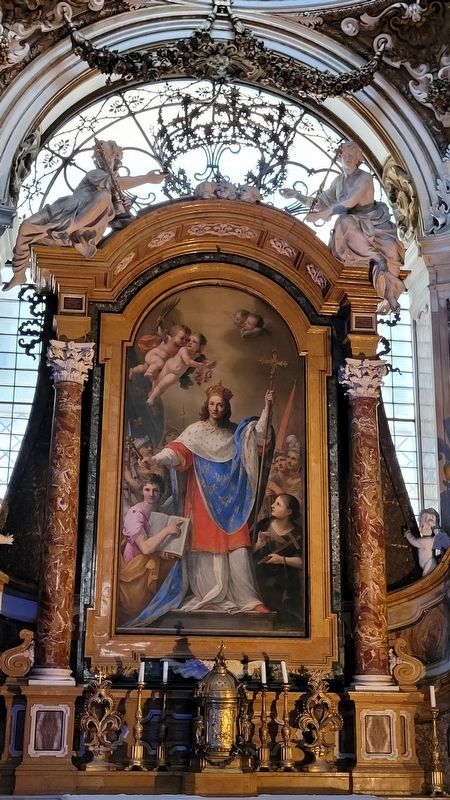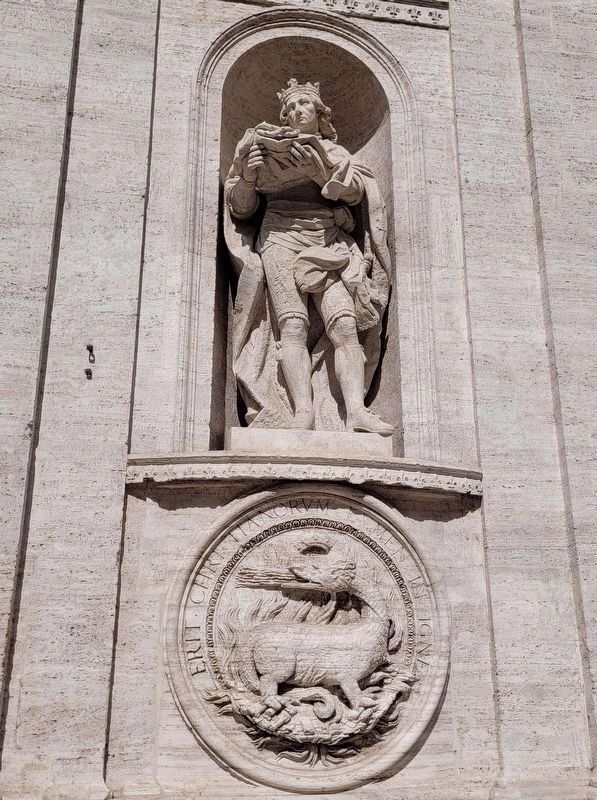Sant'Eustachio in Roma in Città metropolitana di Roma Capitale, Latium, Rome, Italy — Central Italy (Tyrrhenian Coast)
Chiesa di San Luigi dei Francesi / Church of St. Louis of the French
Inscription.
Architetti: G. della Porta (1533-1602), D. Fontana (1543-1607), A. Dérizet (1697-1768)
Nel 1478 la Colonia Francese a Roma, ottenne una permuta con l'abbazia di Farfa, che possedeva un terreno nei pressi di piazza Navona in cui sorgevano alcune chiese; nello stesso anno papa Sisto IV (1471-1484) confermò la permuta e riunì le chiese in una sola parrocchia intitolata alla "Concezione della Beata Vergine Maria, a S. Dionigi e a S. Luigi, re di Francia" (patroni della Nazione Francese), ed istituì una Confraternita con lo stesso nome, primo nucleo della Congregazione dei Pii Stabilimenti Francesi, che ancor oggi amministra le fondazioni religiose della nazione, a Roma e a Loreto. Fra il 1508 e il 1518 fu autorizzata la costruzione della nuova chiesa - la più importante della Nazione Francese a Roma - sul luogo delle preesistenti fabbriche religiose e su parte della piazza antistante. La costruzione del tempio dei Francesi iniziò nel 1518 sotto la direzione di Jean Chenevières, e nel 1531 era già in parte edificato, anche se le vicende architettoniche furono lunghe e si conclusero solo alla metà del Settecento. Della struttura imposta all'edificio dall'architetto lionese nella fase iniziale (probabilmente una piccola chiesa rotonda), non rimane tuttavia quasi nulla. Nel 1524 il cantiere ebbe infatti un momento di stasi, dovuto in parte al Sacco di Roma del 1527 ed in parte alla mancanza di fondi; i lavori ripresero durante il pontificato di Paolo III (1534-1549), e dal 1549 iniziò una nuova fase costruttiva durante la quale fu impostata la pianta longitudinale della chiesa. Un momento significativo nelle vicende architettoniche del tempio francese si ebbe alla fine del Cinquecento, grazie alle generose donazioni di Caterina dei Medici, regina di Francia, che cedette anche un intero isolato annesso al suo palazzo (attuale palazzo Madama) per l'ampliamento della chiesa e per l'ospedale dei Francesi. Responsabile della fase conclusiva della struttura fu Giacomo della Porta, probabilmente in veste di supervisore progettuale ed autore del disegno del prospetto, coadiuvato da Domenico Fontana (all'epoca architetto di fiducia di papa Sisto V), a svolgere le mansioni di capomastro nell'effettiva realizzazione della facciata. Questa fu compiuta fra il 1580 e il 1588, nella forma di un ampio prospetto a due ordini rivestito di travertino e sormontato da un timpano triangolare, in cui furono rielaborati elementi del lessico architettonico michelangiolesco;
nella nuova facciata tardo-cinquecentesca fu inoltre inserito parte del materiale scultoreo tratto dal distrutto tempio dello Chenevières. Lo spazio interno della chiesa è qualificato da una pianta a tre navate (senza transetto) scandite da massicce arcate separate da pilastri, definite lateralmente da cinque cappelle per parte, concluse da un profondo presbiterio e coperte da un'elaborata volta a botte; l'ambiente, rivestito da sontuosi parati di gusto rococò, da stucchi e da una profusione di marmi pregiati, si presenta oggi nell'aspetto decorativo dovuto all'intervento di Antoine Derizet, architetto della Congregazione Francese dal 1742, autore degli stucchi sofisticati della volta e della realizzazione della cupola con il lanternino, impostata all'incrocio della navata centrale con la zona presbiteriale. Nonostante le aggiunte settecentesche e i rimaneggiamenti ottocenteschi, le cappelle della chiesa di S. Luigi sono un vero e proprio museo della pittura romana a cavallo del Cinque e Seicento; fra tutti gli interventi eminenti si possono ricordare: quello del Domenichino, negli affreschi della cappella di S. Cecilia (vero inizio della pittura classicista romana); di Guido Reni, autore della pala d'altare con S. Cecilia della stessa cappella (cópia del dipinto di Raffaello, oggi nella pinacoteca di Bologna); del Caravaggio, nelle celeberrime tele dedicate a S. Matteo (ultima
cappella a sinistra). Dalla sacrestia (posta in fondo alla navata destra) si accede al palazzo di S. Luigi, ricostruito sulla destra della chiesa tra il 1702 e il 1712 da Carlo Bizzaccheri.
Architects: G. della Porta (1533-1602), D. Fontana (1543-1607), A. Dérizet (1697-1768)
In 1478 the French Community in Rome negotiated an exchange with the Abbey of Farfa that possessed land near Piazza Navona where several churches stood; the same year Pope Sixtus IVth (1471-1484) confirmed the exchange uniting the various churches into a single parish in honour of "The Conception of the Blessed Virgin Mary, St. Dionigi and St. Louis, King of France" (patron saints of the French nation), and also set up a Confraternity with the same name, the first ever nucleus of the Congregation of French Religious Establishments, that is still in charge of France's religious institutions in Rome and in Loreto. Between 1508 and 1518 permission was granted to build the French nation's most important church in Rome where the other churches already stood including part of the square in front. Building began in 1518 and was directed by Jean Chenevières; by 1531 part of the building had been completed but the entire procedure was to continue for many years and the church was not ready until the mid-XVIIIth
cent. Very little has survived of the building's original structure as designed by the architect from Lyons (probably a small round church). Work stopped in 1524 and remained closed further to the Sack of Rome in 1527 and because of a lack of funds; work started up again during the Papal rule of Paul IIIrd (1534-1549), and in 1549 a new building phase began during which the church's longitudinal ground plan materialised. An important turning point in the French church's architectural history occurred at the end of the XVIth cent. when Caterina de' Medici, the Queen of France, generously donated funds and also ceded a whole street block attached to her own palace (now Palazzo Madama) so that the church might be enlarged with the addition of a new French Hospital. Giacomo della Porta was in charge of the final stage of building and probably supervised designs; he also designed the façade and was assisted by Domenico Fontana (at that time Pope Sixtus Vth's trusted architect), who was master builder during the actual building of the façade. The façade was built from 1580 to 1588 and with its wide two-ordered church front faced in travertine and surmounted by a triangular gable, comprised a reworking of architectural elements that were recognisably Michelangelesque in style; as well, some sculptures taken from the destroyed church built by Chenevières were incorporated into the new
late-XVIth cent. façade. The church interior comprises a three-naved ground plan (with no transept) divided by enormous arches sectioned off by pillars; there are five chapels on each side, a deep presbytery and an elaborate barrel-vaulted ceiling. The interior is decorated throughout with sumptuos Rococo-style hangings, stuccoes and great quantities of fine marble. These decorations were styled by Antoine Derizet who became the French Congregation's architect in 1742 and designed the sophisticated ceiling stuccoes, also completing the dome with its lantern, positioned above where the central nave crosses the presbytery area. Decorations were added in the XVIIIth cent. and renovations took place in the XVIIIth cent., but the chapels in the Church of St. Louis constitute a very fine museum of painting in Rome between the late XVIth and the early XVIIth cents.; major works include frescoes by Domenichino in the Chapel of St. Cecilia (marking the start of the Classical school of painting in Rome); an altarpiece depicting St. Cecilia by Guido Reni in the same chapel (copied from a painting by Raphael now in the Pinacoteca of Bologna); and Caravaggio's highly renowned paintings of St. Matthew (last chapel to the left). At the far end of the right nave the sacresty leads into Palazzo di San Luigi, rebuilt to the right of the church from 1702 to 1712 by Carlo Bizzaccheri.
Erected by
Ministero per i Beni e la Attività Culturali, Direzione Regionale per i Beni Culturali e Paesaggistici del Lazio, Soprintendenza per i Hent Architettonici e per il Paesaggio per il Comune di Roma, Progetto Mirabilia and Piano di Comunicazione del Patrimonio Culturale Nazionale.
Topics. This historical marker is listed in these topic lists: Architecture • Arts, Letters, Music • Churches & Religion. A significant historical year for this entry is 1478.
Location. 41° 53.985′ N, 12° 28.486′ E. Marker is in Roma, Lazio (Latium, Rome), in Città metropolitana di Roma Capitale. It is in Sant'Eustachio. Marker is at the intersection of Piazza di San Luigi de' Francesi and Via Giustiniani, on the left when traveling north on Piazza di San Luigi de' Francesi. The marker is located on the northeast corner of the church. Touch for map. Marker is at or near this postal address: Piazza di S Luigi de' Francesi 22, Roma, Lazio 00186, Italy. Touch for directions.
Other nearby markers. At least 8 other markers are within walking distance of this marker. Piazza della Rotonda (about 180 meters away, measured in a direct line); Hotel del Sole (about 180 meters away); Rione III Colonna / Colonna District III (about 180 meters away); Pantheon (about 180 meters away); The Trevi-Pantheon Route (about 210 meters away); Hotel Pantheon (about 210 meters away); L'eclisse / The Eclipse
(approx. 0.3 kilometers away); Pamphilj Palace on Navona Square (approx. 0.3 kilometers away). Touch for a list and map of all markers in Roma.
Also see . . .
1. Caravaggio. Wikipedia
Michelangelo Merisi (Michele Angelo Merigi or Amerighi) da Caravaggio, known as simply Caravaggio; 29 September 1571 – 18 July 1610), was an Italian painter active in Rome for most of his artistic life. During the final four years of his life he moved between Naples, Malta, and Sicily until his death. His paintings have been characterized by art critics as combining a realistic observation of the human state, both physical and emotional, with a dramatic use of lighting, which had a formative influence on Baroque painting.(Submitted on July 27, 2023, by James Hulse of Medina, Texas.)
2. San Luigi dei Francesi. Wikipedia
The Church of St. Louis of the French (Italian: San Luigi dei Francesi, French: Saint Louis des Français, Latin: S. Ludovici Francorum de Urbe) is a Roman Catholic church one block east of Piazza Navona in Rome. The church is dedicated to the patron saints of France: Virgin Mary, Dionysius the Areopagite and King Louis IX of France.(Submitted on July 27, 2023, by James Hulse of Medina, Texas.)
Credits. This page was last revised on July 27, 2023. It was originally submitted on July 26, 2023, by James Hulse of Medina, Texas. This page has been viewed 46 times since then and 15 times this year. Photos: 1, 2, 3, 4, 5, 6, 7, 8. submitted on July 27, 2023, by James Hulse of Medina, Texas.
